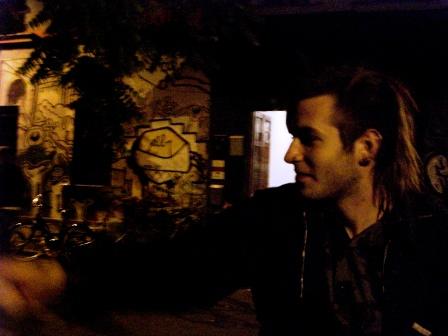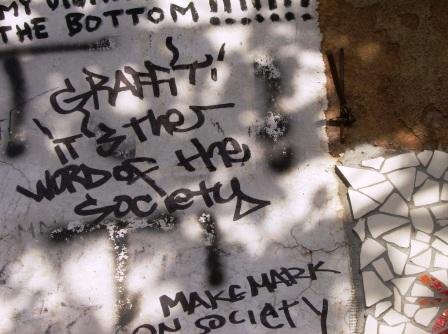taz: temporary autonomous zone
the spirit of metelkova...
The
first time I stood in Metelkova on a Friday night I
thought that here, if anywhere, is an autonomous zone. There were four
different bands playing in the surrounding clubs and hundreds of people
were drinking,
smoking, and generally having fun. Metelkova is not meant to appeal to
the
mainstream. It is a place free of the influences of the state and
hegemonic
culture; yet when you look, you see more than just a giant party. It is
an
institutionalized setting. Without the institutionalized setting it
would have
died out years ago.
The idea of a TAZ (temporary autonomous zone) is explored in
an article written by Hakim Bey. He describes zones of “space, time, or
imagination” that can be liberated to create a free culture. They
disappear as
soon as they are named or identified, only to spring up somewhere else.
It is
cultural resistance without engaging the state, and it continues only
as long
as possible suppressors don't know it exists or have no way of
understanding
the form of resistance. Metelkova cannot be said to be part of this
framework.
It is named, it is defined, and it is an institution that has
experienced
attack after attack from the mainstream media and from the municipality
of
Ljubljana. It is not a specter that the state fails to see. The
situation that
created the space, the original squatting, was a manifestation of this
TAZ
phenomenon. The place was squatted and it was liberated, but the
intention was
to make something permanent. It is a sizable plot of valuable land
technically
owned by the city. This kind of uninstitutionalized space could not
continue on
a permanent basis, especially in the face of the concerted attempts by
the
media to portray the place as a haven for junkies and drug dealers. The
stated
purpose of Metelkova is to create space for alternative culture and
art, but at
the same time it also protects the space liberated by the TAZ uprising
from
threats to destroy it. In this way, the institution that is Metelkova
today is
the footprint of a TAZ. But that isn't all that there is to say about
Metelkova
and the concept of TAZ.
While
Metelkova itself is permanent and constantly needs to
directly resist the state through negotiation, there is still an
element of the
TAZ in its appeal. One of the original squatters who worked as
Metelkova's PR
agent in the early years, Miha Zadnikar, reminised about a
time that
Manu Chao, the famous musical artist, came to Ljubljana. According to
Miha,
Manu Choa's manager refused to set up and play in Metelkova, preferring
one of
the more mainstream venues. Later that night, Manu Chao showed up at
Metelkova
with his guitar and played in front of the open kitchen for himself and
two
hundred others. It was not planned by Metelkova's organizers. It simply
happened. Something similar happens every Friday night when several
hundred
people gather almost by coincidence in Metelkova. Bands play in the
venues on
the edges of the complex and the clubs play more mainstream music in
order
to
attract crowds and sell beer. In the middle is a vast crowd of
people
smoking, drinking, playing music out of their car stereos or
strumming on
their own guitars, all talking and mixing. The actual physical space is
perfect
for this. All the buildings face in towards large open spaces; people
form
crowds outside the clubs and mix. Sometimes a small group will kick a
bottle between
them or throw a Frisbee around while standing among the crowd, somehow
managing
to not hit anyone who isn't playing despite the number of people in the
area.
This
is the TAZ. There are between 80 and 100 organized
events in Metelkova in any given month, but it is the party that most
people
come for. I have asked some fifty people “Why do you come here?” and
every
single one has mentioned the party. But this space isn't simply a place
to
socialize. Miha said that the city government doesn't understand
Metelkova and
focuses on the legalization of the institutions and overlooks what is
really
important. When I asked what that was, he said “many small things” and
gave me
an example that struck me as odd: “Silence.” During the day, Metelkova
can be a
tranquil place, which is another function of the spatial freedom.
Metelkova is
a group of clubs and artist's studios that share a space and try to
promote
alternative media and culture. But almost more importantly, it defends
a space
that is culturally liberated and open to all. The TAZ within Metelkova
is its
spirit.
punk roots
the transformation of city space...

The
task of squatting Metelkova in the early 90s was no
small feat. It took months of struggling with the City of Ljubljana and
the
Government Republic of Slovenia before the two declared the former
military
barracks as space usable by the Network for Metelkova.
The original founders of the cultural space utilized their knowledge of
Slovenian laws as well as excellent organizational techniques
efficiently and
successfully. Despite the many changes that have occurred over the past
15 years,
many participants believe Metelkova has retained the original punk
mentality in
its operations, valuing aesthetics and politics that challenge
mainstream
conventions. The punk community has historically been
associated with squatting and
has undoubtedly influenced the plan of action for the space. The Do-It-Yourself ethos pervades its volunteer-run
cultural
spaces, artist residences, and political activism. Yet other users of
the
space are unconcerned about this ethos and believe it has declined in
recent
years.
Many
of the teenagers who frequent Metelkova on the weekends
have said that they do so because of its location, lax alcohol policy
and
semi-closed quarters; it gets them off the street and gives them a
place to be
on weekends. Metelkova is a safe haven where they are less likely to
get
approached and questioned by police officers. Several teenagers have
commented
that they have met numerous intimate friends there and have virtually
no other
place to go. Coincidentally, there seems to be a link between coming to
Metelkova simply to socialize and a lack of historical knowledge about
the
space itself.
Young
adults who are more connected with the punk scene in
Slovenia expressed some discontent with how Metelkova has changed
within just
the past five years. In their opinion, Metelkova is now overrun with 14
and 15-year- olds who attend simply to drink heavily and talk with
friends; they remain
clueless about the struggles that the Network for Metelkova has had to
go
through in order to secure the space. Other self-proclaimed punks
lamented the
current state of Metelkova due to its alleged severance with punk
aesthetics.
Older
persons involved with Metelkova focus on the positive
effects that the center has but were also open about issues that it
faces.
According to Natasa, an original squatter, there were over 80 events
happening
at Metelkova each month in the late 1990s, of varying origin. She
argues that
“music was always the main culture” in the beginning and Metelkova has
since
then expanded to include “other social groups” who want to utilize the
space.
She believes this is why more outsiders are now involved and Metelkova
is not
so empty in the daytime.
Original
participants grew up in the Tito and post-Tito eras,
when Yugoslavia trumpeted its system of worker self-management and mix
of
socialist, communist, and social democratic economics.
Although worker self-management lost energy
and was abandoned when Slovenia became independent, the ideas of
collective
decision-making and shared public resources remain hallmarks of
Metelkova’s
practice in some areas.
graffiti
a vital form of community expression...

The
graffiti present in Metelkova is not only a
strong aesthetic
characteristic, but also ingrained in its cultural background. The
purveyors of
visual art in the space have utilized the previously bleak and
crumbling walls
of the former “Fourth of July” military barracks to reflect the
communal ideals
of artistic expression and appreciation in the space provided. The
walls of
Metelkova have changed innumerable times over the last 15 years; even
though
the content may be different, the spirit is still present today.
Metelkova
has faced continual criticism through the years. Many
inhabitants in Ljubljana believe that the street art in Metelkova has
influenced lowbrow and amateur artists to add their graffiti to
commercial
buildings and other non-approved spaces throughout the city. According
to
Natasa, an original founder, some of Metelkova’s neighbors recently
wrote to
the mayor of Ljubljana to complain that the cultural center encourages
graffiti
artists to tag their houses.
If
Metelkova’s visual art does inspire unprofessional
artists to create works in Ljubljana, the issue at hand may be that
they feel
they are below the level of doing their work in an artistic space like
Metelkova. This may inspire them to try minimal pieces throughout the
city in
order to improve their skills or increase recognition. Anrea, an
artist-in-residence from London, believes this is a possible
explanation. It
may also be plausible that street artists intend to create intricate
designs
but are deterred by the possibility of facing legal charges if caught. According
to a local DIY artist, the consequence for creating graffiti in the
city is a fine around 2,000 Euro.
Apparently
there is an informal code of conduct when
creating art within Metelkova as well. Anrea commented that artists
have an
‘anything goes’ policy that gives them the freedom to do designs as
they wish.
Despite this freedom, they are still bound by a common respect for
others’ art.
He recently painted a beautiful black and white rat on the front of the
Metelkova 6 building and noted that he only utilized space that did not
have
much going on. Each artist at Metelkova uses his or her own personal
judgment
when choosing both the piece to create and the space to decorate. This
freedom
of artistic expression and creation is truly enviable and independent
artists
may be attempting to emulate this sovereignty.
“Like any other real city, Metelkova also embraces public spaces intended for association, amusement, flow of information and inspiration. Although sometimes the opinion prevails that Metelkova is one single artists studio, the place actually offers a whole bunch of other adventures. Namely, if Metelkova did not have any open public space, the majority of us would not have anything to do there, would we? Who would like to hang around in a studio? Needless to say that studios would not perform their function either.”
– Tom d’Elf
For more information about Anrea, please see the interviews section.
Also check the photo gallery to see a collection of graffiti images.
